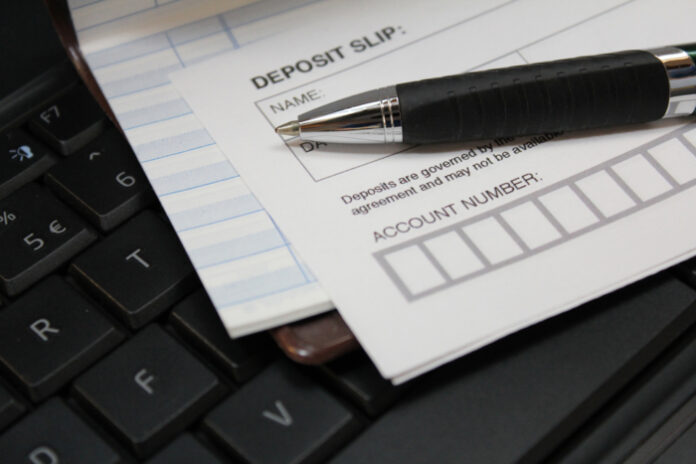As a business owner or freelancer, you will know how important depositing money is for your cash flow and for your profits.
There are several different ways that you can get money into your business. Customers can pay for goods and services in different ways, including cash, checks, card and even eWallets these days. You might get investment money from a bank loan or through financial backers, for example.
Cash payments and other deposits can become a bit of a nightmare, especially in these digital times where most businesses are accepting online payments and using card machines. While these payments are usually faster and require less work for the business, they often incur charges and fees for the company, which is why cash still remains king in many ways.
With this being said, getting cash and check payments into your business account means that you will need to actually visit a physical bank, and that means you need to use a deposit slip.
What Is a Deposit Slip?
Although we are easing into a more online world, even in banking, there are still certain things that you will need to do in a physical bank — and one of those things is paying in cash (or checks).
The deposit slip is a small piece of paper that you hand into the bank with the cash and checks that you want to put into your account, and it tells the bank teller what you are depositing and where you want it to go.
Why Do We Use Deposit Slips?
If you were to turn up at a bank with a fistful of dollars and a handful of checks, you’d have to give the teller all the details verbally — how much you are giving, and where you want it to go. This can obviously lead to mistakes, and it will take an awfully long time to sort out.
Using a deposit slip helps you ensure that all the cash and checks are accounted for, that you know how much you are going to receive into your account, and that you have an opportunity to ensure that all the details are correct (especially the account number, for example).
Bank-Specific Variations
Each bank may have its own deposit slip format. Common examples include:
| Bank / Institution | Notes on Deposit Slip |
| Chase | Account number may be prefilled; separate lines for cash and checks |
| Wells Fargo | Allows subtotaling for multiple checks; signature optional |
| Bank of America (BOA) | Often includes ATM instructions for deposits |
| Credit Unions | Vary by location; always confirm if business or personal slip is needed |
Always verify with your bank if using business deposit slips or for special accounts.
What Goes on a Deposit Slip?
Each bank will have a specific deposit slip that they want you to use, but the details are broadly the same. You will need to include the following:
- The date: This is important because you will need to record when you are depositing the cash and checks for your accounting (and it will make a difference for the teller who is recording it).
- Account number: If your deposit slip does not have this prefilled, you will need to add this to the slip to direct the cash and checks to where they need to go.
- Total amount of cash.
- Total amount of checks: make sure the checks are appropriately endorsed.
- Signature.
When you have completed this, hand the deposit slip with the cash and checks to the teller. Some people may use the ATM to complete this transaction, but many business owners find that physically handing it to the teller is faster and more secure (using the ATM might mean that the deposit is not completed immediately.
How to Fill Out a Deposit Slip (Simple Breakdown)
If you are filling out a deposit slip for the first time, the process is straightforward once you understand the order.
Start by writing the current date at the top of the slip. This helps the bank process the deposit correctly and supports your own accounting records. Next, carefully enter your account number. If your slip is pre-printed, double-check that the number matches your account.
After that, enter the cash amount, if applicable, in the designated cash section. Then list each check individually, writing the amount clearly. Once all checks are listed, add them together and write the total in the “total checks” field.
Finally, add the cash and check totals to calculate the total deposit, and sign the slip if required by your bank.
Common Mistakes on a Deposit Slip
Some things to avoid if you want to make sure your deposits are accurate:
- Not filling the slip out completely.
- Using the wrong account details.
- Forgetting to endorse checks.
- Trying to deposit third-party or post-dated checks.
- Leaving the amounts ambiguous.
- Putting in the wrong amounts.
For the very best results, make sure that you take your time filling the form out, that you double check the total amounts for both checks and cash, and when you write the totals down, that you include them in both numbers and words.
When you have done it a few times, all these details will become second nature.
How Business Owners Should Handle Deposit Slips
For businesses, deposit slips are part of accurate financial recordkeeping. Listing checks individually helps with reconciliation and simplifies bookkeeping later. Many businesses also keep copies of deposit slips or photographs for accounting and tax purposes.
If your bank offers night deposits or business ATMs, make sure you understand whether a deposit slip is still required. Using the correct slip type for your business account ensures deposits are processed without issue.
Deposit Slip Tips to Avoid Delays or Rejected Deposits
Even small errors on a deposit slip can delay your deposit or require correction at the counter. Writing clearly and double-checking totals can prevent most problems.
Always ensure checks are properly endorsed before depositing them. Avoid rounding numbers or leaving sections blank, as this can cause confusion during processing. If you’re depositing a large amount, consider asking the teller to verify the totals before final submission.
Keeping your deposit organized not only saves time but also reduces the risk of posting errors in your account.
Business Deposit Slips
Tips for accurate business deposits:
- Use a business-specific deposit slip when available
- List checks individually for proper accounting
- Separate cash and check totals
- Retain copies for tax and bookkeeping purposes
Step-by-Step Example of a Deposit Slip Filled Out
- Write today’s date in the top box.
- Enter your account number.
- Fill in cash total ($150).
- List checks individually:
- Check 1: $200
- Check 2: $350
- Total checks: $550
- Total deposit (cash + checks): $700
- Sign at the bottom if required
This is an example of a deposit slip filled out to guide you.
How to Correctly Fill a Deposit Slip
- Use clean, legible handwriting.
- Include all cash and checks clearly.
- Double-check totals.
- Endorse checks appropriately.
- Confirm the account number is correct.
- Submit to a teller or deposit via ATM if supported.
Conclusion
Filling out a deposit slip doesn’t have to be complicated. Whether you are depositing cash, a single check, or multiple checks for your business, the process follows the same basic steps. By understanding how to fill out a deposit slip correctly, you can save time at the bank, avoid errors, and ensure your funds are deposited smoothly. Keep a few blank slips handy, double-check your amounts, and always retain your receipt for reference.
FAQs: How to Fill Out a Deposit Slip
1. How do you fill out a deposit slip for cash?
To fill out a deposit slip for cash, write the date, your account number, and the amount of cash you want to deposit. Enter the total in the “cash” section and sign the slip if required.
2. How do I fill out a deposit slip for a single check?
Write the date, your account details, and the check amount in the “checks” section. If there is only one check, list it in the first line and total it at the bottom.
3. How can I fill out a deposit slip with multiple checks?
List each check separately on the deposit slip or use the back of the slip if you have more than the available lines. Add the amounts together and enter the total in the “total checks” section.
4. Do I need to fill out a deposit slip for business deposits?
Yes, business deposits usually require a deposit slip. Follow the same process as personal deposits—include all checks and cash amounts clearly and double-check totals for accuracy.
5. Can I deposit both cash and checks using one deposit slip?
Yes. Write the cash amount in the “cash” section and list the checks in the “checks” section. Add both amounts for the total deposit.
Find a Home-Based Business to Start-Up >>> Hundreds of Business Listings.

















































